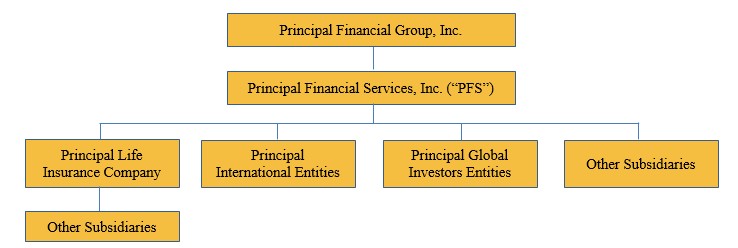Item 3. Legal Proceedings
Disclosure concerning legal proceedings can be found in Item 8. “Financial Statements and Supplementary Data, Notes to Consolidated Financial Statements, Note 13, Contingencies, Guarantees, Indemnifications and Leases” under the caption, “Litigation and Regulatory Contingencies” and Item 8. “Financial Statements and Supplementary Data, Notes to Consolidated Financial Statements, Note 11, Income Taxes” under the caption, “Other Tax Information,” which are incorporated here by this reference.
Information about our Executive Officers
The following information is furnished with respect to our executive officers, each of whom is elected by and serves at the pleasure of the Board of Directors.
W. Y. (Thomas) Cheong, 54, has been Executive Vice President of the Company since January 2021 and President, Principal Asia of the Company since March 2019. Thomas is from Singapore and is located in our Hong Kong office. Previously, he was Senior Vice President of the Company from March 2019 to December 2020 and served as Vice President, Head of North Asia of the Company from January 2015 to February 2019. Prior to that time, he held several leadership roles in various Asia markets at Manulife Financial Corporation from October 2009 to December 2014 and Prudential UK from October 2000 to September 2009.
Amy C. Friedrich, 52, has been President, U.S. Insurance Solutions since May 2017. Prior to that time, she was Senior Vice President of the Specialty Benefits insurance division of U.S. Insurance Solutions since 2015, and Vice President of Specialty Benefits since 2008.
Patrick G. Halter, 63, has been President and Chief Executive Officer of Principal Asset Management of the Company and Principal Life since November 2022. Prior, he was President of Global Asset Management of the Company and Principal Life since November 2020 and Chief Executive Officer for Principal Global Investors, the investment management firm within our Global Asset Management business, since September 2018. Previously, he served as Chief Operating Officer of Principal Global Investors, since 2016 and was Chief Executive Officer for Principal Real Estate Investors, the dedicated real estate unit of Principal Global Investors, since 2003.
Daniel J. Houston, 61, has been a director of the Company and Principal Life and President and Chief Executive Officer of the Company and Principal Life since August 2015. Prior to that date, he held the same positions except was Chief Operating Officer (and not Chief Executive Officer) since November 2014. Previously, he served as President, Retirement, Insurance and Financial Services of the Company and Principal Life since 2010. He was President, Retirement and Income Solutions of the Company and Principal Life from 2008 until 2010, and was Executive Vice President, Retirement and Income Solutions of the Company and Principal Life from 2006 to 2008.
Kathleen B. Kay, 60, has been Executive Vice President of the Company and Principal Life since March 2022 and Chief Information Officer of the Company and Principal Life since May 2020. She was Senior Vice President of the Company and Principal Life from May 2020 to March 2022. Prior, she was Senior Vice President and Chief Information Officer of Pacific Gas & Electric Company from 2015 to 2020. Previously, she served as Enterprise Chief Technology Officer at SunTrust from 2012 to 2015, Senior Vice President, Business Technology Services of Comerica Bank from 2007 to 2012 and Director, Application Development and Support, OnStar of General Motors from 1984 to 2007.
Natalie Lamarque, 46, has been Executive Vice President and General Counsel of the Company and Principal Life since July 2022 and Secretary of the Company and Principal Life since October 2022. Prior to joining the Company and Principal Life, she was with New York Life Insurance Company in various roles, including General Counsel from March 2020 to June 2022 and Deputy General Counsel from 2019 to 2020, both while a Senior Vice President; Vice President in Corporate Compliance from 2016 to 2019; and Associate General Counsel from 2014 to 2016. Previously, she was an Assistant U.S. Attorney in the Criminal Division of the U.S. Attorney’s Office of the Southern District of New York from 2007 to 2014. Prior to that, she was an attorney at Debevoise & Plimpton LLP from 2004 to 2007.
Christopher J. Littlefield, 56, has been President, Retirement and Income Solutions since March 2022. Previously, he was Executive Vice President and General Counsel of the Company and Principal Life since January 2020 and Secretary of the Company and Principal Life from March 2020 to March 2022. Prior to that date, he was President and Chief Executive Officer of Fidelity & Guaranty Life Insurance Holdings from October 2014 to December 2018. Previously, he served as President and Chief Executive Officer of Aviva USA Corporation from February 2009 to October 2013 and served as Chief Operating Officer of Aviva USA Corporation from February 2008 to September 2009. Prior to that, he served as Executive Vice President, General Counsel and Secretary of AmerUS Group Co. from January 2006 to February 2008.
Kenneth A. McCullum, 58, has been Senior Vice President and Chief Risk Officer of the Company and Principal Life since September 2020. Prior to that date, he was Vice President and Chief Actuary since April 2015. Prior to that time, he served as Executive Vice President responsible for business development and in force management at Delaware Life Insurance Company from August 2013 to April 2015 and Senior Vice President responsible for managing the life and annuity businesses at Sun Life Financial from April 2010 to August 2013. Previously, he held several positions at the Hartford from August 1994 to April 2010, including leading its institutional investment products division and serving as Chief Actuary of its legacy holdings division.
